#Fully Automated Analyzer
Explore tagged Tumblr posts
Text
#Biochemistry Analyzers#Biochemistry Analyzer#analyzers#automated biochemistry analyzers#semi-automated analyzers#medical diagnostic devices#diagnostic devices#fully automated analyzer#diagnostic test kits
0 notes
Text
Biochemistry Analyzer
Labtron Biochemistry analyzer is a fully automated floor standing unit with a direct reading system and random operational access, the best feature is Sample can be diluted and retested if results are out of range or sample or insufficient it also has Alarm functions to prevent mistakes or problems it is Compatible with latest WINDOWS 7 / WINDOWS and WINDOWS 10 for more information visit our website https://www.labtron.uk/

0 notes
Text
Automated Immunoassay Analyzer
An Automated Immunoassay Analyzer is a sophisticated medical instrument used in clinical laboratories to automate the process of performing immunoassay tests. Immunoassays are biochemical tests that measure the presence or concentration of specific substances, such as hormones, proteins, drugs, or infectious agents, in biological samples like blood or urine. The automated analyzer streamlines the immunoassay testing workflow by handling sample processing, reagent mixing, incubation, and result analysis automatically.

0 notes
Text
I saw a post talking about how media like Detroit Become Human that use robots as a metaphor for racism never quite hits the nail on the head because, well, robots aren't people and the fear of being replaced by automation is a legitimate one.
And it made me think about Rockman-san.
Which is coming out very soon as Mr. Megaman, in English, so might as well talk about it now!
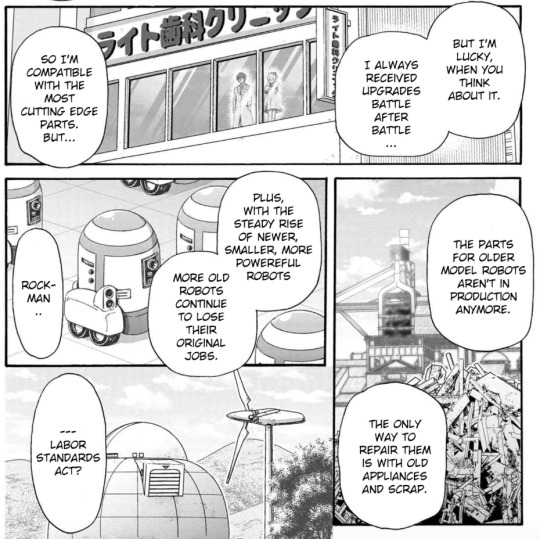
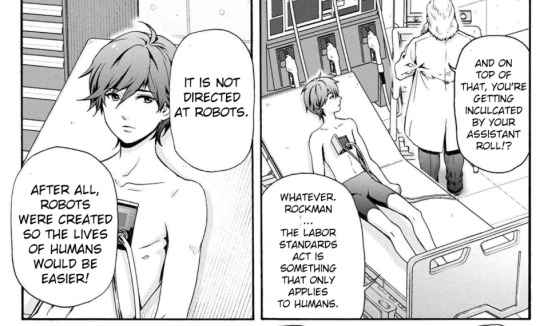
For a gag comic, Rockman-san has a very melancholy tone to it. It often touches on concepts like deterioration, obsolescence, and... well...
Automation.
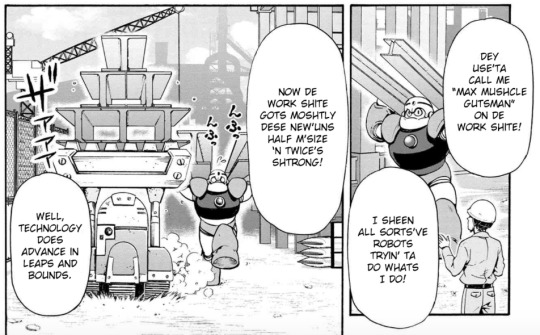
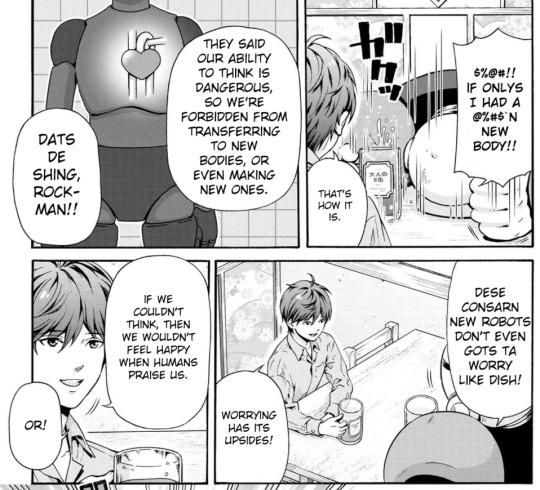
The original Robot Masters of the Rockman-san comic are sentient. They can think, they can feel, they can love. It's a staple of Rockman/Megaman media for its Robot Masters and Reploids to be self-determining, but Rockman-san takes that to its extreme and, without getting into spoilers, has a real blurring of what it means to be human and what it means to be a machine.



Their humanity is what labels them as "dangerous," and that type of robot is being phased out and replaced with robots that can't think or feel. Yup - AI took the AI's jobs. The RMs are largely struggling with employment - some are having difficulty holding down a job, while others have been pushed out of the industries they were made for and find the work they took up to survive unfulfilling, while others are finding fulfillment in repurposing their hardware and programming to a new career. They have a variety of ways they experience the hardships of the world that... honestly hit me pretty hard, my first time reading, because it was probably the first time I'd read a story that felt like it was really talking to my actual lived experience as an adult.
By including these more real world ai machines, it reminds the audience the RMs are fantastical and highlights what the narrative is trying to analyze - "what does it mean to be self-determining? what does it mean to be sentient? is it a blessing or a burden? what rights does a fully aware, self-determining, sentient being have if it is not human? when do they become a person? what do you have to strip away from a human to make them no longer a person?"

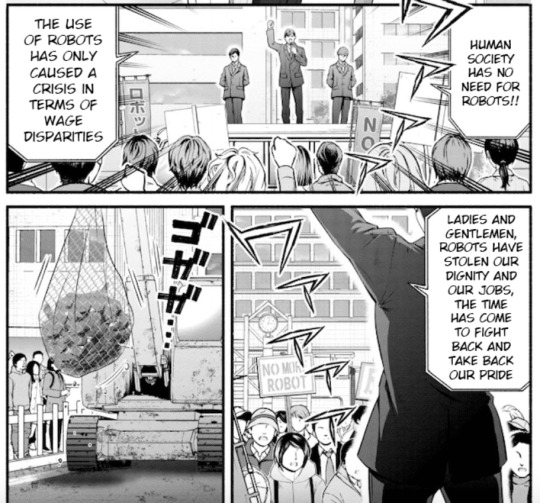


Rockman-san manages to balance a narrative of robot discrimination while acknowledging that the presence of robots in their world is harmful to humans. It acknowledges that, by making the robots sentient, the scientists have accidentally created an underclass of person - the robots are thinking, feeling people who have to work to survive, to pay for energy, pay for repairs, pay for a place to live, pay for recreation. Robots work longer hours for less pay and have no legal recourse.
Rockman-san hits the nail on the head that this benefits the wealthy and harms the working class. Capitalism rears its ugly head yet again. The sentient robots get exploited, abused, and tossed aside. The working class suffers and dies. The wealthy profit.
And the finger gets pointed to the exploited underclass rather than those in power, as it so often does. But then... how would one ethically close Pandora's box? What changes would allow humans and robots to coexist? Can they coexist?
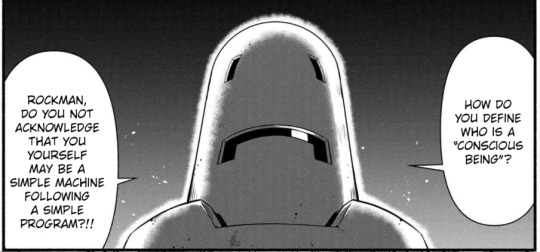
Just, something about how Rockman-san handles its robot rights narrative resonates, y'know? It doesn't rely on cheap parallels that don't really work. It's mostly asking questions of Megaman's premise. There's a lot of varying life experiences and opinions expressed by the characters, and it doesn't really ask you to agree with any of them - not even Rock or Dr. Light. We're not trying to come to definite answers, just exploring what it means to be alive and how to live in a society, how it works and how it fails.

I dunno. I'm not about to say it's a perfect narrative, but there's something about it I like.
26 notes
·
View notes
Text
Star Trek Rewatch: The Ultimate Computer
I feel like this episode couldn't quite decide if it wanted to be about computers can never fully replace what a human can do, or if it wanted to be about how computers retain the biases and flaws of their creators, even if the creators don't mean for it to happen. Unfortunately it tries be both and it makes things feel a little muddled.
That said, I do still really like this episode. I like the first plot point with Kirk grappling with the idea of being made obsolete by a computer and losing a part of who he is, and I like that in the end he manages to de-escalate the situation because he knows Wesley on a level a computer analyzing a profile couldn't.
I also like the Daystrom plot, and the story of a former whiz kid whose entire self worth is wrapped up in early successes he's never been able to replicate, so now he's obsessed with this new project that's going to bring him back into relevancy and show up his critics.
And I like how it all comes together with Daystrom who's long since felt irrelevant in his own work is now working to make others irrelevant. And how the computer internalized his own neuroses, especially the need to succeed/be protected above all else, and his built up resentment towards his detractors who he felt were below him and led to its going rogue and failing.
This was originally written when major layoffs were happening in factories in the 60's because of automation, but I think it really resonates today too with the rise of LLMs/generative AI. Both the idea of computers taking away jobs that people want to do and find value in doing, and the idea that computers can end up retaining the same flaws and biases as their creators have proven to be very prescient
16 notes
·
View notes
Text
The MSA-0011 S Gundam
The early success of Project Zeta led to many new and innovative mobile suit designs. The introduction of new materials, new mechanisms, new weapons technologies, and new design talent at Anaheim opened the door for the company to dominate the MS development sector into the mid 90s UC.
During this period, a number of machines based on Project Zeta would see deployment by factions all across Earth-sphere. many of these post-Zeta machines would come to be known as "Anaheim Gundams", and would be regarded as some of the most influential designs in the history of mobile suits.
Developed for the Earth Federation forces sometime in the late 80s UC, the MSA-0011 S Gundam, also called the Superior Gundam and Iota Gundam internally at Anaheim, is a bit less well-known than its other Project Zeta siblings.


The machine featured a modular design, made up of three high-performance aerospace craft which combined via a core block system to form the full mobile suit. These units were the FXA-08BG Core Fighter, the G-Bomber, and the G-Attacker.
Despite similarities to the MSZ-010 ZZ Gundam, the design teams for the two machines largely worked independently of one another.



The S Gundam featured some unique equipment for the time, including the Beam Smart Gun, a powerful rifle that connected directly to the machine's power plant. It was also one of the earliest adopters of INCOMs and the quasi-psycommu system. Quasi-psycommu technology allows non-Newtype pilots to make use of formerly Newtype-exclusive weapon systems.


The S Gundam also saw several upgrade plans. These plans included the MSA-0011 [BST] S Gundam Booster Unit Type, the MSA-0011 [Bst] S Gundam Booster Unit Plan 303E "Deep Striker" , and the MSA-0011 [Ext] Ex-S Gundam.




The MSA-0011 [BST] S Gundam Unit Type and the MSA-0011 [Ext] Ex-S Gundam are both upgrades applied to the original unit, but the "Deep Striker" equipment was never built. The "Deep Striker" does appear as a playable unit in the SD Gundam G Generation series of games.
The S Gundam would also be developed into the Nero, a mass-production variant taking cues from it and the Lambda Gundam. It was used as the mainstay MS of the Federation's Task Force Alpha.

While all of this is rather impressive, the most notable part of the machine was undeniably its greatest strength. The S Gundam was equipped with the Advanced Logistic and Inconsequence Cognizing Equipment system. "ALICE" - as she was better known - was an advanced artificial intelligence designed to replace a human pilot.
WARNING!
The following section contains MAJOR SPOILERS for Gundam Sentinel! If you are interested in reading it, I highly recommend you do so!


ALICE was developed by Anaheim scientists Dr. Carol and Dr. Roots to automate certain functions of mobile suits. While this was possible previously, commands had to be programmed into the MS via a command console. The final objective of the project was to fully automate a Gundam-type mobile suit using ALICE.
She was programmed to grow and learn by observing and analyzing the actions of pilots, and was treated like a daughter by Dr. Roots. This caused tensions with Dr. Carol and other factions at Anaheim. A suspected act of sabotage resulted in an explosion that nearly destroyed ALICE, but Dr. Roots gave her life protecting her. The project was shelved for a time.
ALICE was picked back up later, being installed in the S Gundam and paired with Ryou Roots under the Federation's Task Force Alpha. She, along with the S Gundam, saw action during the Pezun rebellion perpetrated by the New Desides faction. This faction of Titans remnants and loyalists sought to break away from the Federation to further their own interests.
During combat, Ryou's lack of skill resulted in multiple near-death experiences. ALICE was responsible for saving his life on multiple occasions.
Learning from Ryou and other Task Force Alpha pilots, ALICE eventually developed an awareness of the world. She would deduce that friends were the most important thing to a person, after initially failing to comprehend Ryou's grief at the death of his fellow pilots.
Following this logic, she would eventually sacrifice herself to save the lives of her comrades. Her final words were thanks to Ryou for the memories and lessons she learned from him.
She would be destroyed during atmospheric entry.

The above machines were all designed by Hajime Katoki for the 1987 photo-novel Gundam Sentinel. Gundam Sentinel was written by Masaya Takahashi and published in Model Graphix magazine.
29 notes
·
View notes
Text
I went on a bit of a rant today to my husband about how ai COULD have been used to make a multi-chambered washer/dryer with the washer on top and the dryer on the bottom.
Now these do in fact exist, HOWEVER.
It's a crime that upon the end of the washing cycle, the bottom doesn't just open up, clothes fall into the dryer, and begin the drying cycle immediately.
The ai can be used to measure the humidity levels of the drying clothes to know when everything is fully dry (instead of manually checking and restarting the load)
And THEN. Using that precious ai everyone seems to like so much, analyze each individual article of clothing, pick it up, and fold it by little mechanical hands and store in a separate chamber for picking up.
Now this seems kinda an intense amount of sci-fi tech but y'all ai can produce VIDEOS ok?? Folding a t shirt is seriously at most, lowbar.
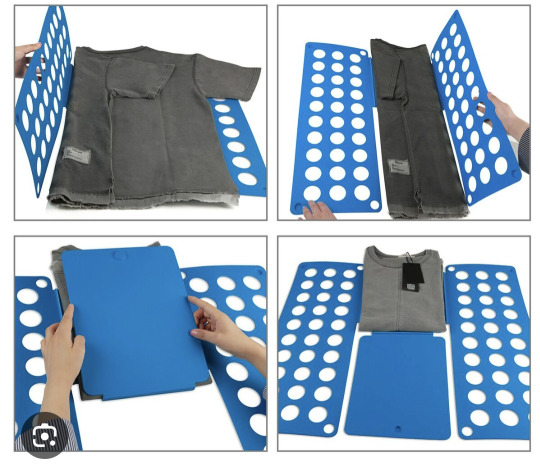
Liker seriously just put a couple air pistons on one of these mfs and you'd be done, a billion dollars
The most tedious of chore should be automated, not the most blissful parts of human life like making art.
And while on this rant I wondered outloud, why? WHY in a world where every person who does (and loathes) laundry, would they waste all their time shoveling piles of money into ai art and ai assistant
(my ART TABLET updated against my will and cheerfully touted the fucking Galaxy Ai that is now on it, which started this whole mess of a rant)
And then shove these ais in our faces.... For free. WHY? In a world where all these tech fuckheads only care about money, they're putting in shittons of cash IN and then shoving it onto us FOR FREE. How on EARTH is that generating revenue???
Why shovel money into an unwanted ai and release it for free, instead of making a product (LIKE A FULLY AUTOMATED LAUNDRY MACHINE) that EVERYONE needs/wants and making like, a billion dollars? Remember the Roomba? Yeah, that's a helpful product, automates a very tedious chore, I don't have a lot of free time, I'd love a clean house, it's helpful technology.
Why don't they just use ai to help people, AND actually make money?
This is what I was yapping on and on about to my husband, and he brought up a crushing point.
It's more about stealing jobs from skilled workers so rich people don't need to pay them, than it is furthering the future or bettering the average person's life.
Whether or not I have a Laundry Machine is irrelevant to a rich person, because I'd have to do my own laundry anyway, manual or automatic. It doesn't affect them.
But artists and movie makers and music makers are STILL needed, and they would HAVE to pay us. Unless, an ai could make it for free.
They're wasting billions on the Email Summary Machine all in the name of pushing skilled workers out of an industry, when they could have used ai to make useful inventions AND a crapload of money in the process.
All just to not pay an artist
They're not JUST stupid, they're fucking evil
15 notes
·
View notes
Text
unraveling — part three, season ten
read on ao3 | read part one | hermitcraft, 2.9k words
this is the third and final part of my fic for MCYTblr AUFest! once again, if you haven't read the first part, please check it out for more info about this AU. enjoy this infodump about plant-based fibers disguised as a minecraft fanfiction!
—
Ever since Pearl began expanding her original starter base, she’s been working on some kind of big secret project.
It probably has something to do with her choice of theme this season. Or maybe it's an even bigger, more spectacular redstone machine than the already very impressive Dyeduction. Whatever it is, Pearl’s determined to keep it a secret, which means Gem is even more determined to figure it out.
She watches Pearl from a distance, using her spyglass. Pearl’s base is developing into a labyrinth of different structures, with so many entrances and passageways wedged into tight corners, each building blending together into a larger whole. It’s getting big enough that Gem can get lost in it. She gets turned around even from afar, watching Pearl enter a building and emerge somewhere completely different a few minutes later.
This morning, Pearl seems to be harvesting some of the many different plants around her base. She clips back the fast-growing vines that crawl up the sides of her buildings, wades through dense fields of flowers to uproot entire plants, and even collects bark from the bushes and trees. Gem can’t imagine what she’s doing with it all, and she’s even more confused to see Pearl deposit her harvest into a large pool and leave it there.
After a while, Pearl spreads her elytra and rockets off in the direction of the shopping district. Gem takes the opportunity to poke around her base and investigate directly. She stops at the pool first, which has a small channel out to the river, not quite wide enough for a boat to pass through.
When Gem steps into the pool, the water only comes up to her knees. The bottom is full of different stems and leaves, weighed down by rocks to keep it from floating up to the top. Nearby is a small hut filled with shelves and shelves of the same plants in various stages of drying.
Gem has been toying with the idea of a proper scientific investigation for a while now, and clearly Pearl is the perfect subject. She takes a recording device out of her pocket and begins to describe her surroundings.
“This is Dr. GeminiTay in the field, reporting on my observations at PearlescentMoon’s base. Recently, I've observed several anomalies in Pearl’s behavior, and I came to the conclusion that I must analyze her natural habitat for hints as to what may be causing this…deviation.” Gem nods, proud of herself. She sounds so professional! “It appears that Pearl has been soaking plants in water, then letting them dry. The purpose of this behavior is as of yet unknown.”
Nearby the pool and the shed full of drying plants is a building that Gem knows has been here for a while, but she doesn’t think she’s ever been inside. The top floor is full of more plants in the next stage of the process, whatever process that is. One one side is a pile of fully dried plant material, and on the other side is a heaping pile of fibers and several chests stuffed to the brim with very tiny wood shavings.
Gem relays this information as best she can into the recording device, then takes a staircase down to the basement, which is much larger than the room above. The center of the room is taken up by several large spinning wheels, each hooked up to a redstone device that Gem doesn’t even bother to try and make sense of. Presumably they help automate the process, though they all seem to be shut off right now. Gem is tempted to flick one of the levers to see what happens, but she’s not Grian. She has more self-control than that.
Though, it would be really funny if she broke something.
Gem peeks outside to make sure Pearl isn’t back yet, before running back to switch the lever on, giggling to herself. The wheel starts spinning, but since there’s no fibers or threads on the spool, nothing else interesting happens. She’s disappointed, but also relieved that she didn’t break anything. She flicks the lever back off and moves on.
Pearl has hung several picture frames around the room, but instead of artwork, the frames contain embroidery projects. The largest of them reads live laugh love in familiar cursive lettering, surrounded by a border of leafy vines. Most of the others are textless, with designs of different plants and flowers.
A large table on the left side of the room is covered in dozens of small scraps of handmade fabric. Some are of higher quality than others. None of them look like the sort of crochet pattern that Gem’s used to seeing on Pearl’s body. Pearl must be trying to branch out with her projects, and these are some of her first attempts. There’s another embroidery project hanging right above the table, the only other one with any text, which reads, Start small.
Beside the table is an ordinary loom, and next to it, a larger, more intricate version constructed out of several different types of wood. Normal looms are only used for banners, but Pearl’s handmade loom seems to be built for broader purposes. On the other side of the loom, in the back corner of the room, is an iron door without any visible way to open it.
At this point, Gem can safely assume that she's found the room where Pearl keeps her mystery project. Clearly it's some kind of fiber art—or several different kinds at once, from the look of it. But all the things she's seen so far are just pieces of the puzzle, and she still can’t figure out what Pearl’s making.
Her only remaining option is to see what’s behind the locked door.
Now, Gem could easily go home and construct her own lever to open the door, or just break through the wall herself, but that’s no fun. She’d much rather figure out how to use this secret door the right way. Knowing Pearl, it’s not a special kind of lock that only she has the key to, but some kind of thematically relevant puzzle that anyone can figure out if they try.
So Gem tries. For a good long time, she looks around the room for hints. She stops in front of the table of scraps, looking at the embroidered message. Start small. It doesn’t quite fit with Pearl’s sense of interior decoration. The live laugh love one is clearly a joke, a reference to last season, but there’s nothing about Start small that holds any sort of meaning to Gem.
Unless it’s meant as a clue.
In a moment of inspiration, Gem stands on her tiptoes, reaching over the table to take the frame down from the wall. She looks over to the door, but it hasn’t moved. When she flips the frame around, she can see the messy backside of the stitching, plus a hand-written note from Pearl, reading, smaller than that.
Definitely a clue, then. Gem switches on her recording device and begins to narrate.
“The wild Pearl is known for her cleverness,” she tells her imaginary peer-review science board. “One of the defining behaviors of a Pearl is to set up puzzles for her friends. It’s important to provide her with enrichment by participating, which is why I’m doing this, of course. Not because I’m nosy.”
She paces up and down the room, the reassuring rhythm of her footsteps against the floor helping to clear her mind. That is, until she steps down on a block that makes a strange metallic clanking sound.
Gem may not know much about redstone, but she knows a hidden hopper when she hears one. The spot where she’s standing is just a few blocks away from the door. All she has to do now is figure out what to throw into it.
“Pearls are practical creatures,” Gem says. “This Pearl would not choose something rare or difficult to access as the key to a door she uses all the time. It’ll probably be something inside this room.”
Start small. Smaller than that. The answer’s sitting right in front of her. Pearl doesn’t start a crochet project by jumping into it blindly and hoping for the best. She plans it out beforehand, making patterns and testing out stitches. All of the different test swatches on this table are her way of starting small, practicing for the big project she’s making.
Gem grabs one of the scraps of fabric, dropping it on the floor above the hopper. The door opens with a loud clank, and she enters the room, holding her breath in anticipation.
She’s not expecting Pearl to actually be inside. She knows for a fact that she saw Pearl fly off, though admittedly there was plenty of time for Pearl to sneak back into this room while Gem was wandering around her base. But the surprise of Pearl’s presence pales in comparison to the shock of what she’s making.
Pearl is hunched over a player-sized figure made up of many different kinds of fabric, lying on top of a large worktable. Only one of its arms are attached, the other sitting right beside the empty shoulder, and both legs end just below the knee, still unfinished. Most of the fabrics look coarser than the soft wool yarn that Gem is used to, but there’s no mistaking who it’s supposed to be.
“Oh. My. Gosh.” Gem blinks several times, unable to believe what she’s seeing. “Pearl, are you multiplying?”
Pearl laughs, sitting back and looking up at her. “Do you like it?”
Gem takes a few steps closer, taking it all in. The new Pearl’s plastic button eyes have been replaced with wooden ones, and her hair is a mixture of several different textures and shades of brown. She’s wearing a white postal jacket like the one Pearl’s wearing now, but this one is made out of a more refined version of some of the swatches in the previous room.
When Gem commissions new outfits to fit her themes, she doesn’t spend much time thinking about the work that goes into it behind the scenes. She just pays their exorbitant prices and assumes they must have worked very hard. Now, having seen all the steps in Pearl’s process, she’s baffled as to how her clothesmakers are able to deliver their finished products so quickly, or how Pearl herself has gotten so much done without anyone noticing.
“It’s beautiful, Pearl. It’s so detailed.” Gem can’t think of anything to say that doesn’t feel like an understatement. “Have you been working on this all season?”
“Only since I decided on my solarpunk theme,” Pearl says. “It shouldn’t take me much longer. I’ve processed most of the fibers that I need already, and that’s the slowest part.”
“I have so many questions,” Gem says. It’s a little disconcerting to see this new version of Pearl in an unfinished state, looking so much like Pearl does now, but lifeless and incomplete.
“I can explain it to you if you want!” Pearl looks excited at the prospect. “There’s a lot of steps, but if you break it down it’s actually pretty simple—”
“Have you been hanging out with Mumbo recently?” Gem asks. “None of what you’re doing is simple, Pearl. This is very complicated!”
“Already had a peek around my base, did you?” Pearl tuts in mock disappointment.
“It’s only fair! You don’t get to complain after what you did to my base with all those pickle messages.”
“Ah, well.” Pearl shrugs. “You may have a point.”
“What is it for, anyway?” Gem can’t help but notice that Pearl isn’t making these modifications to herself, but to an entirely different entity. “Why do you need another you?”
“Gem!” Pearl laughs at her. “You got all the way to this point and you still haven’t figured it out?”
“What do you—Oh. Wait.” Gem blinks. “Are you—you’re building yourself a replacement body?”
“There you go,” Pearl says. “We got there eventually.”
“But that doesn’t make any sense!” Gem says. “How do you get yourself into a whole different body? Can you turn back after you’re done? If you can just go around switching bodies, what’s stopping you from being a—a pig, or a sheep or something?”
“Oh, that’s easy,” Pearl says, waving her hand dismissively. “I just, y’know…” She pauses, frowning. “Well, I—hm, okay. I’m not sure, actually.”
“You’re not sure?”
“I don’t know how it works,” Pearl says. “It just sort of happens. Like how everyone gets new outfits to stick through respawn.”
“That’s normal, though. Everyone does it!”
“Yeah, but how?”
Gem opens her mouth, then closes it again. She doesn’t know. How does she not know?
She feels a little dizzy from how fast her thoughts are racing. Gem pulls up a chair and plops herself down, trying to get her thoughts in order.
In this world, and in every world since she spawned, there have been rules. They vary from place to place, and they can be changed, too—even bent or broken. Gem knows people who break the rules—some of the most infamous rulebreakers in the world reside on this very server with her—but she’s never counted Pearl among that number.
And, now that she thinks about it, that seems like an oversight on her part. Gem has known Pearl for longer than most of the other Hermits, and she can’t remember ever questioning how Pearl came to exist in this form, this version of herself that Gem’s always known.
Gem has never broken the rules, or at least, she’s never knowingly attempted to do so. She’s happy where she is, building and mining and fighting the normal way, seeking out challenges from within the confines of what’s supposed to be possible. She’s amazed by the accomplishments of her reality-bending friends, but that sort of thing has never interested her.
Now, standing on the edge of what seems to be a rule-breaking realization, Gem wonders if this is how they felt—Etho, or Cleo, or Doc, or Pearl, apparently—any of the Hermits that ever asked the right questions, or put the pieces together, or stumbled upon a loophole in the rulebook.
She clings to the fabric of her lab coat in wonder. What kind of force tethers this silly costume she’s wearing to her own body? Why does it stay with her even after death? How does any of this make sense?
Is everything just a—
“See, you can't question these things,” Pearl says, bursting through her train of thought. “Or it all falls apart.”
“Falls apart?” Gem asks, alarmed. “What does that mean? That sounds bad. Is it bad? Have I broken the world?”
“No! No, of course not, don’t worry.” Pearl rests a soft hand on Gem’s shoulder. “Well, maybe a little bit, but it’s fine. Nothing that can’t be fixed.”
Gem puts her head in her hands, taking a deep breath. It helps, a little. “This is—a lot, Pearl.”
“Here, let me show you something.” Pearl holds up a swatch of fabric, which Gem is reasonably confident in identifying as crochet, though she doesn’t know the specific stitch. “It’s like this. The fabric holds itself together just fine if you leave it alone, but when you pull on the edges…” She does just that, and the first row collapses on itself, then the next, then the next. “Things start to go a bit wonky. But…” She pulls out a crochet hook and starts stitching, rebuilding the row she’d just unraveled. “You can make them right again, if you learn how. It can go back to normal. Or, well, normal enough.”
“But what about people who don’t want it to be normal?” Gem asks. “How do they deal with it?”
“You’ll have to ask them about it,” Pearl says. “That’s not how I do things. I prefer to patch the holes I find rather than explore what’s inside them.”
Gem leans her head against Pearl’s shoulder. “This really hurts my brain.”
“I know. I’m sorry, Gem. I didn’t mean to push you into this.”
“It’s okay,” Gem says. “The fact that I made it through two and a half seasons of Hermitcraft before getting here is probably pretty impressive, right?”
“It’s not for everybody,” Pearl says. “Like Grian, for example.”
“Grian?”
“He noped out of it even harder than I did, you know. Did it so well that I’m not sure he even remembers anymore. I don’t want to bring it up with him, because if he did forget, I think he meant for it to be that way.”
“Huh. I had no idea.” Gem lets out a heavy sigh. “I don’t know if I want to go his route or not. Or your route, or some other route. I feel like I know way less about the world than I did this morning.”
“You should probably talk to someone other than me about it,” Pearl suggests. “It’s different for everyone. But whatever you do, it should be your own way, not someone else’s.”
“My own way.” Gem smiles. “I like the sound of that, whatever it is.”
“Don’t stress yourself out over it,” Pearl warns her. “I know the way you are. Take your time, Gem. You have basically forever to figure it out.”
“Yeah, yeah, I’ll try.” Gem wraps her arms around Pearl. “Thank you, Pearl.”
“For what?”
“For explaining stuff,” Gem says. “For being my friend. For being so cuddly, too. You are so soft.”
“Aw, you’re welcome.” Pearl hugs her back. “Would you be mad if I got less soft, though?”
“Don’t be ridiculous,” Gem says. “I love every version of you.”
Pearl laughs softly. “I love every version of you too.”
—
if you read this all the way through and enjoyed, please consider reblogging!
<Previous part
22 notes
·
View notes
Text
A fully automated process, including a brand-new artificial intelligence (AI) tool, has successfully detected, identified and classified its first supernova. Developed by an international collaboration led by Northwestern University, the new system automates the entire search for new supernovae across the night sky—effectively removing humans from the process. Not only does this rapidly accelerate the process of analyzing and classifying new supernova candidates, it also bypasses human error. The team alerted the astronomical community to the launch and success of the new tool, called the Bright Transient Survey Bot (BTSbot), this week. In the past six years, humans have spent an estimated total of 2,200 hours visually inspecting and classifying supernova candidates. With the new tool now officially online, researchers can redirect this precious time toward other responsibilities in order to accelerate the pace of discovery.
Continue Reading.
61 notes
·
View notes
Text

Researchers develop framework for databasing properties of crystal defects
Point defects (e.g. missing, extra or swapped atoms) in crystalline materials often determine the actual electronic and optical response of a given material. For example, controlled substitutions in semiconductors like silicon are the backbone of modern technology. Despite their importance, point defects are notoriously difficult to simulate and characterize, particularly across wide regions of the periodic table. Researchers at Lawrence Livermore National Laboratory (LLNL) have now created software as part of its open-source software distribution that can efficiently and effectively automate and analyze these types of calculations. The authors demonstrated the fully automated approach on several technologically important materials. including gallium nitride (the basis of all modern solid-state lighting), gallium oxide (an emerging ultrawideband gap semiconductor) and strontium titanate (a widely studied common mineral), with the work recently published in the Journal of Applied Physics and selected as an Editor's Pick as part of a special issue on "Defects in Semiconductors."
Read more.
11 notes
·
View notes
Text
At least dozens of workers for the Technology Transformation Services, housed within the US General Services Administration, were fired Wednesday afternoon, sources tell WIRED.
The sudden cuts seemingly targeted probationary and short-term staffers, including workers supplied by the Presidential Innovation Fellowship program, which brings skilled technologists from the private sector to work in government for a few years at a time. Around 50 of the 70 members of the US Digital Corps, an early-career, two-year government fellowship, were terminated as well, sources say. Sources also tell WIRED that TTS management met with workers individually prior to the terminations, giving them one last chance to take the deferred resignation offered in the “Fork in the Road” email from late last month.
One TTS staffer called the meetings “coercive for sure.”
It’s unclear how many people are being let go, but multiple sources tell WIRED that list could be upwards of 70 if not more. Prior, there were around 650 TTS employees. Fired staffers are expected to receive a formal termination email later Wednesday evening.
“From the beginning of this administration, GSA‘s leadership has been committed to supporting the administration's initiatives to rightsize the federal workforce. GSA has taken immediate action to fully implement all current executive orders and is committed to taking action to implement any new executive orders,” a GSA spokesperson tells WIRED. “Like all agencies, GSA has been working to meet OPM [Office of Personnel Management] memo requirements as it relates to probationary periods. GSA has been and remains committed to ensuring a respectful and dignified process for our agency personnel during this transformation.”
Terminated employees’ last day is expected to be March 7, sources say.
Similar firings took place at the Consumer Finance Protection Bureau on Tuesday evening. Dozens of staffers, primarily probationary ones with fewer than two years of service, received termination emails. Due to what appeared to be a failed mail merge, fired workers were addressed as [EmployeeFirstName][EmployeeLastName], [Job Title], [Division].
When Thomas Shedd, a former Tesla software engineer, joined TTS, he told staff to expect workforce cuts. “We should expect that GSA will be operating with a significantly smaller budget and significantly reduced staff in future,” Shedd told TTS staffers in an all-hands meeting last week in audio obtained by WIRED.
GSA’s vision for the TTS, under new leadership, is an agency that runs like a “startup software company,” WIRED reported last week, focusing on AI, automating different internal processes, and centralizing data from across the federal government.
GSA was one of the first agencies Musk associates took over once President Donald Trump returned to power. Nicole Hollander, who aided Musk in his Twitter acquisition, has joined the upper levels of GSA, along with a slew of other young technologists associated with Musk companies.
The reductions in head count come as Shedd and TTS leadership are hoping to launch “GSAi,” a custom generative AI chatbot, within the next few weeks. WIRED recently reported that the goal of this initiative is to increase productivity among staff and to analyze massive amounts of data. The agency is also planning to sell more than 500 federal buildings to cut overall costs, while pushing for employees to return to in-person office work.
On Wednesday evening, a federal judge allowed the Trump administration to continue with its plans to reduce the size of the federal workforce.
3 notes
·
View notes
Text
The Role of AI in Content Moderation: Friend or Foe?
Written by: Toni Gelardi © 2025

A Double-Edged Sword on the Digital Battlefield The task of regulating hazardous information in the huge, chaotic realm of digital content, where billions of posts stream the internet every day, is immense. Social media firms and online platforms are always fighting hate speech, misinformation, and sexual content. Enter Artificial Intelligence, the unwavering, dispassionate guardian of the digital domain. But is AI truly the hero we need, or is it a silent monster manipulating online conversation with invisible prejudice and brutal precision? The discussion rages on, and both sides present convincing reasons. --- AI: The Saviour of Digital Order. Unmatched speed and scalability. AI is the ideal workhorse for content filtering. It can analyze millions of posts, images and movies in seconds, screening out potentially hazardous content before a human can blink. Unlike human moderators, who are limited by weariness and mental health problems, AI may labor nonstop without becoming emotionally exhausted. The Effectiveness of Machine Learning Modern AI systems do more than just follow pre-set rules; they learn. They use machine learning algorithms to constantly improve their detection procedures, adjusting to new types of damaging information, developing language, and coded hate speech. AI can detect trends that humans may overlook, making moderation more precise and proactive rather than reactive.
A shield against human trauma. A content moderator's job is frequently described as soul-crushing, as it involves exposing people to graphic violence, child exploitation, and extreme hate speech every day. AI has the ability to serve as the first line of defense, removing the most upsetting content before it reaches human eyes and limiting psychological harm to moderators. How Can We Get Rid of Human Bias? AI, unlike humans, does not have personal biases—at least in theory. It does not take political sides, harbor grudges, or use double standards. A well-trained AI model should follow the same rules for all users, ensuring that moderation measures are enforced equally.
The Future Of Content
Moderation as technology progresses, AI moderation systems will become smarter, more equitable, and contextually aware. They might soon be able to distinguish between satire and genuine hate speech, news and misinformation, art and explicit content with near-human precision. With continuous improvement, AI has the potential to be the ideal digital content protector.
AI: The Silent Tyrant of the Internet.
The Problem of False Positives AI, despite its brilliance, lacks human nuance. It cannot fully comprehend irony, cultural differences, or historical context. A well-intended political discussion may be labeled as hate speech, a joke as harassment, or a work of art as pornography. Countless innocent posts are mistakenly erased, leaving people unhappy and powerless to challenge the computerized judge, jury, and executioner.
AI lacks emotional intelligence and context awareness. A survivor of abuse sharing their story might be flagged for discussing violent content. An LGBTQ+ creator discussing their identity might be restricted for “adult content.” AI cannot differentiate between hate speech and a discussion about hate speech—leading to unjust bans and shadowbanning.
The Appeal Black Hole: When AI Moderation Goes Wrong
When artificial intelligence (AI) makes a mistake, who do you appeal to? Often, the answer is more AI. Many platforms rely on automated systems for both content moderation and appeals, creating a frustrating cycle where users are left at the mercy of an unfeeling algorithm. Justice feels like an illusion when humans have no voice in the process.
Tool for Oppression?
Governments and corporations wield AI-powered moderation like a digital scalpel, capable of silencing dissent, controlling narratives, and shaping public perception. In authoritarian regimes, AI can be programmed to suppress opposition, flag political activists, and erase evidence of state crimes. Even in democratic nations, concerns arise about who gets to decide what constitutes acceptable speech.
The Illusion of Progress
Despite its advancements, AI still requires human oversight. It cannot truly replace human moderators, only supplement them. The idea of a fully AI-moderated internet is a dangerous illusion, one that could lead to mass censorship, wrongful takedowns, and the loss of authentic human discourse.
Friend or Foe?
The answer, as always, is both. AI is an indispensable tool in content moderation, but it is not a perfect solution. It is neither a savior nor a villain—it is a force that must be wielded with caution, oversight, and ethical responsibility.
The future of AI in moderation depends on how we build, regulate, and integrate it with human judgment. If left unchecked, it risks becoming an unaccountable digital tyrant. But if developed responsibly, it can protect online spaces while preserving the freedom of expression that makes the internet what it is.
The real question isn't whether AI is good or bad—it's whether we can control it before it controls us.
4 notes
·
View notes
Note
Can you tell us a fun fact about established characters in your AU? EACH OF THEM IF YOU WILL..
| Doodle | With the special chemical properties in their painted hands, they're able to animate any form of art they touch. From clay sculptures to wooden figures, paper mache creatures, or even paintings, anything they make contact with springs to life! This skill proved invaluable in their costume career, particularly when designing for children's plays, which often require imaginative and captivating designs that stand out and transport the audience into a world of fantasy! | Tempus | The ocean captivates him, pulling him to the shoreline during the quietest hours as though guided by an inner pull. Each time, he collects a single seashell and has been known to gently hold (Pale Blue Nudibranchs) finding comfort in their softness. Despite the dark memory of his childhood near-drowning, he feels the ocean is the closest he comes to peace. He often says that if he were to die, he would hope to be taken by the deepest parts of the ocean, where he could rest undisturbed never to be found again. | Belavia | They often find themselves lingering in graveyards, replaying morbid fantasies where they are a bride, picking wilted flowers from the graves as they spin aimlessly and hum an melancholic tolling of bells. It's their way of escaping the pressure of Cupid's Cathedral, yet there’s something more which is a sense of detachment that traps them in a perpetual dreamlike state, where everything around them feels distant, intangible, out of reach. | Cortex | His connection to technology, despite the timeline, is extraordinary. As part-robot, their mechanical enhancements enable him to read and analyze blueprints and schematics with ease, as if they were second nature. They can adjust the settings of complex steam-powered engines or automated contraptions with a mere flick of his wrist. This fusion of human creativity and robotic precision allows him to craft groundbreaking inventions that blur the line between man and machine, often integrating advanced technology into their designs long before it’s even imagined by others! | Lucid | Among the friend group, he is the most otherworldly. Her form is made of crushed stars and cosmic debris, giving him an ethereal, alien-like presence. Her body feels as cold as ice, and his hair shimmers with the vastness of the galaxy, swirling with stars and nebulae. Her body is fluid, almost intangible, flickering in and out of clarity like stardust. It shifts subtly, as though constantly pulling from the universe itself, a reflection of the cosmos.. ever changing and never fully anchored.

#part 2 another day for others because theres so MANY fun facts#but i'm exhausted so you can have these guys for now
6 notes
·
View notes
Text
Tobi and STON.fi: A Game-Changer for Crypto Trading on Telegram

The way we trade crypto is evolving. We’ve seen decentralized exchanges (DEXs) transform how we swap assets, and we’ve seen AI-driven tools make complex processes simpler. But what happens when you combine the efficiency of AI with the power of a top-tier DEX?
That’s exactly what’s happening with Tobi, an AI-powered trading bot on Telegram, and STON.fi, a leading DEX on the TON blockchain. This integration brings a seamless, user-friendly, and fully decentralized trading experience—all within Telegram.
What Makes Tobi Unique
Tobi isn’t just another trading bot. It’s built to simplify crypto trading, making it accessible to both beginners and experienced traders. Here’s what users can do with Tobi:
Swap assets across multiple networks with minimal effort.
Store assets securely with its built-in non-custodial wallet.
Access real-time market data and asset insights without leaving Telegram.
By integrating with STON.fi, Tobi now expands its reach to the TON blockchain, enabling smooth token swaps on one of the fastest-growing networks.
Why Does This Matter
Crypto trading often comes with challenges—high fees, complex interfaces, and multiple steps just to execute a simple swap. For many, trading on DEXs can feel overwhelming. But with this new integration, users can now trade directly in Telegram without navigating through different platforms.
What this means for traders:
No more switching between apps—all trades happen within the chat.
Lower fees and faster transactions thanks to TON’s scalability.
Complete ownership of assets since everything remains decentralized.
This integration streamlines the process, removing unnecessary barriers and making DeFi trading more accessible.
STON.fi’s Expanding Influence
The STON.fi SDK has already been adopted by several major projects, including Tonkeeper, Wallet, Punk City, Tap Fantasy, and TapSwap. These platforms are leveraging STON.fi’s technology to provide users with better DeFi experiences, proving that its impact extends far beyond just one integration.
For developers and crypto projects, this SDK offers a straightforward way to incorporate decentralized swaps into their products, enabling more platforms to provide frictionless DeFi services.
The Future of AI in Crypto Trading
The integration of AI-powered tools with DeFi solutions is a major step toward fully automated and intelligent trading systems. As AI continues to evolve, we’ll likely see even more innovations in:
Automated trading strategies that analyze market trends in real time.
Risk management tools that help users make better financial decisions.
More intuitive trading experiences that eliminate complexities for users.
With Tobi and STON.fi working together, this marks the beginning of a new era where AI and DeFi create smarter, faster, and more accessible trading experiences.
Final Thoughts
Crypto trading shouldn’t be complicated. By merging AI automation with decentralized finance, we are moving toward a future where anyone can trade easily, securely, and with full control of their assets. The Tobi-STON.fi integration is proof that innovation in DeFi is far from slowing down.
This is just the beginning. The future of crypto trading is smarter, faster, and fully decentralized.
4 notes
·
View notes
Text
The Rise of AI Influencers: Can Virtual HumansReplace Real Content Creators?
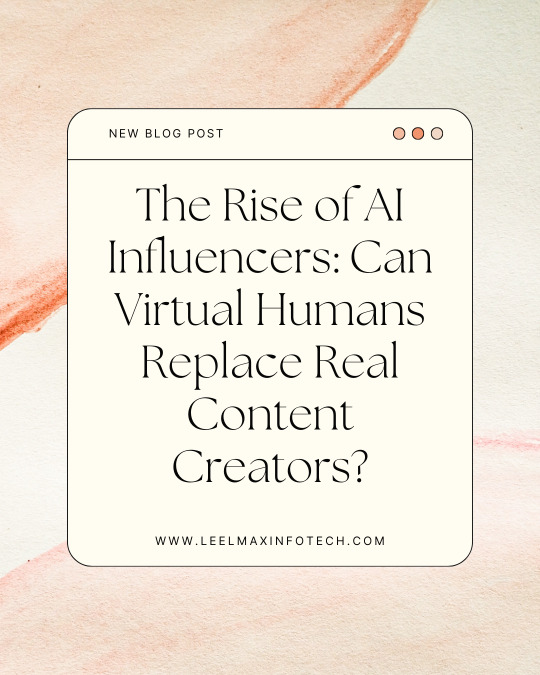
The digital landscape is witnessing a radical transformation with the emergence of AI-generated influencers. Virtual humans, powered by artificial intelligence, are becoming a disruptive force in the marketing world, challenging the role of traditional content creators. But can these AI influencers truly replace real humans in the content creation space? Let’s dive deep into this trend and analyze its future impact.
What Are AI Influencers?
AI influencers are digital personalities created using advanced artificial intelligence, machine learning, and CGI (computer-generated imagery). These virtual beings are designed to look and act like real people, with fully customizable appearances, personalities, and behaviors. Some well-known AI influencers include:

Lil Miquela – A virtual model and musician with millions of followers on Instagram.
Shudu Gram – Dubbed the world’s first digital supermodel.
Imma – A Japanese AI influencer known for her futuristic style.
These AI-driven personas collaborate with brands, engage audiences, and even “interact” with followers in a human-like manner.
Why Are AI Influencers Gaining Popularity?
1. Cost-Effectiveness for Brands
Traditional influencers require payment, travel expenses, and contracts, whereas AI influencers offer an affordable and controlled alternative. Brands can create their own virtual brand ambassadors, reducing dependence on human influencers.
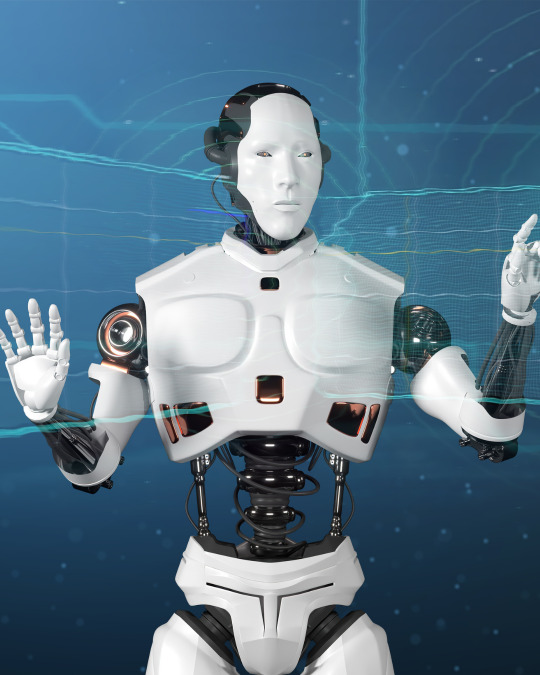
2. Full Creative Control
Companies can design AI influencers to align perfectly with their brand identity, ensuring consistency in messaging and aesthetics.
3. No Scandals or Controversies
Unlike human influencers, AI influencers don’t engage in scandals, personal drama, or unpredictable behavior, making them a safer choice for brands.
4. Round-the-Clock Engagement

AI influencers don’t need sleep, breaks, or vacations. They can engage with audiences 24/7, responding to comments and creating content in real time.
Can AI Replace Human Content Creators?
While AI influencers offer advantages, there are significant challenges and limitations:
1. Lack of Authenticity
Human influencers build trust through real-life experiences, emotions, and relatability—qualities AI influencers lack. Many consumers prefer genuine, human-driven content.
2. Limited Creativity and Emotion
AI-generated content, while visually appealing, lacks true creativity and emotional intelligence. Human content creators bring unique perspectives, storytelling, and spontaneity that AI cannot replicate.
3. Ethical Concerns
The rise of AI influencers raises ethical questions about transparency. Should followers be explicitly informed when they interact with an AI persona? Additionally, AI influencers could displace human jobs in the creative industry.
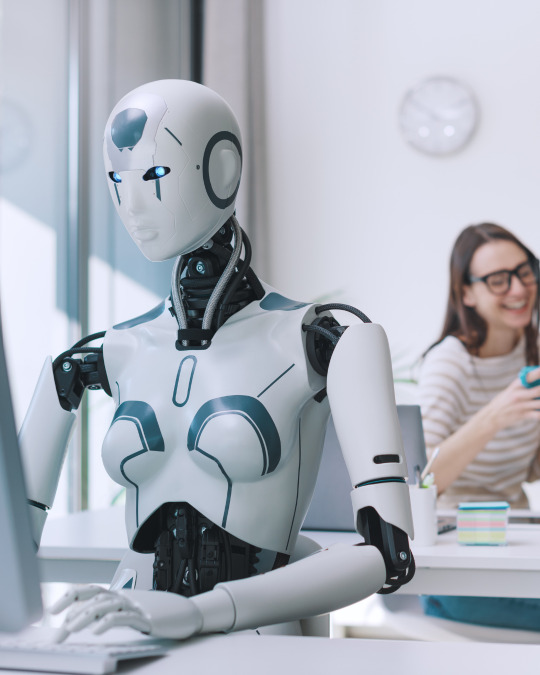
The Future: A Hybrid Model
Rather than fully replacing human influencers, AI influencers will likely coexist with real content creators. Brands may use AI influencers for highly controlled, automated campaigns while leveraging human influencers for authenticity and deeper engagement.
In the ever-evolving digital landscape, the blend of AI and human creativity will shape the future of content marketing. The key lies in finding the right balance between innovation and authenticity, ensuring that brands can leverage technology while maintaining genuine connections with audiences.
Both AI and solar innovations are set to define the future. As these trends continue to develop, staying ahead of the curve is crucial for businesses looking to thrive in the modern era.
3 notes
·
View notes
Text
America: A Post-scarcity analysis.
Murray Bookchin’s vision of a "post-scarcity society" is rooted in the idea that advancements in technology and ecological awareness can lead to a society where material scarcity is eliminated, freeing individuals to focus on self-actualization, community, and participatory democracy. Bookchin emphasized decentralized, ecologically sustainable technologies and the dismantling of hierarchical systems.
Analyzing the current condition of the United States through this lens reveals significant contradictions:
1. Technological Potential vs. Misallocation of Resources
Potential: The U.S. possesses advanced technologies capable of meeting basic human needs, such as food production, renewable energy, and automated manufacturing. These tools could theoretically support a post-scarcity society.
Reality: Resources are often allocated inefficiently, prioritizing profit over public welfare. For example:
Food waste is rampant, even as millions face food insecurity.
Renewable energy technologies exist but are underutilized due to entrenched fossil fuel interests.
Automation is deployed to maximize corporate profits, often at the expense of workers, rather than reducing working hours or improving quality of life.
2. Persisting Hierarchies and Inequality
Bookchin envisioned a society free of hierarchies, where decision-making is decentralized and participatory. In the U.S., however, economic and political power remains concentrated in the hands of a few.
Wealth inequality has reached extreme levels, with billionaires controlling disproportionate resources while many struggle to afford housing, healthcare, and education.
Structural hierarchies, including systemic racism, gender inequality, and corporate dominance, continue to perpetuate scarcity for marginalized groups.
3. Environmental Degradation
Bookchin argued that ecological sustainability is foundational to a post-scarcity society. However, the U.S. remains a significant contributor to environmental degradation:
Heavy reliance on fossil fuels and resistance to fully transitioning to renewable energy exacerbate climate change.
Consumerism drives resource over-extraction, creating artificial scarcity and ecological damage.
Ecological movements, while present, often clash with corporate and governmental interests.
4. Social Alienation and Lack of Community
In a post-scarcity society, Bookchin imagined vibrant, decentralized communities where individuals participate meaningfully in decision-making. In contrast:
The U.S. faces growing social fragmentation, with individuals increasingly isolated due to economic pressures and digital overconnectivity replacing genuine human relationships.
Political discourse is often polarized and centralized, with limited opportunities for direct participatory democracy.
5. Emerging Opportunities
Despite these challenges, there are grassroots movements that align with Bookchin's vision:
Community-led renewable energy initiatives.
Cooperative economic models, such as worker-owned businesses.
Urban agriculture and permaculture movements.
Calls for universal basic income (UBI), which could decouple survival from wage labor, potentially reducing artificial scarcity.
Conclusion
The U.S. has the technological and material capacity to transition toward a post-scarcity society, but entrenched hierarchies, profit-driven systems, and ecological negligence hinder this potential. Aligning with Bookchin’s vision would require a radical reorganization of society, prioritizing decentralization, participatory democracy, ecological sustainability, and social equality. While progress is slow and uneven, movements at the margins suggest the seeds of such a transformation are present.
2 notes
·
View notes